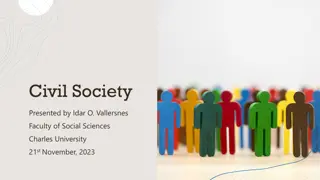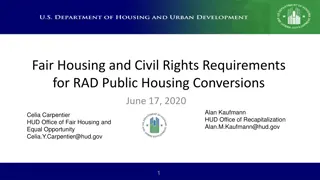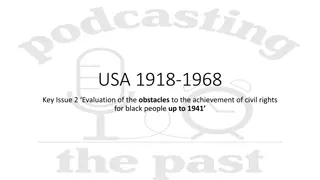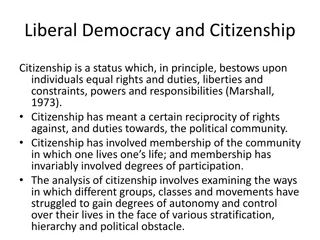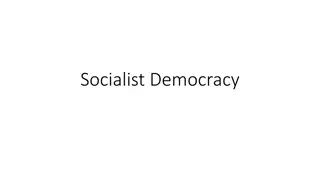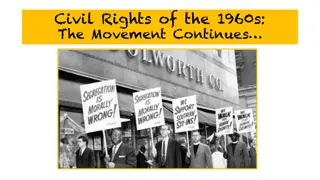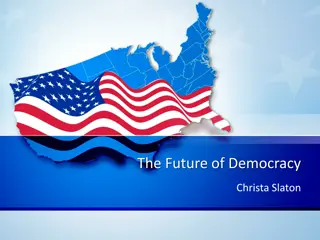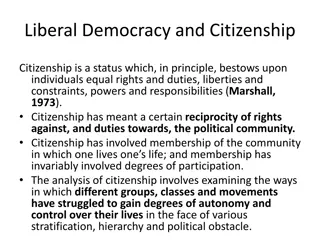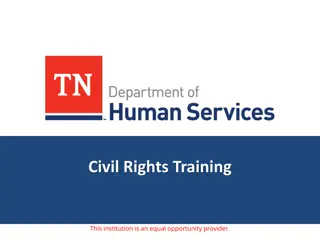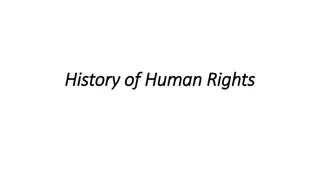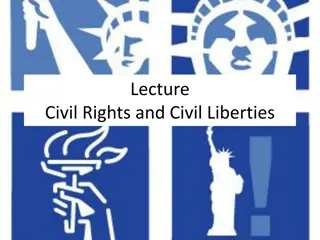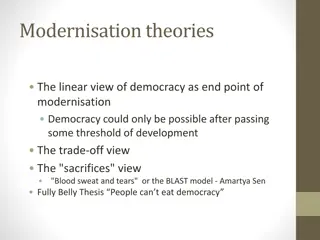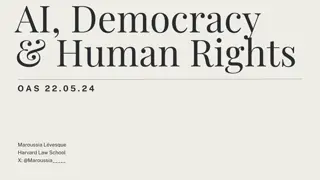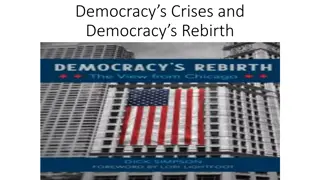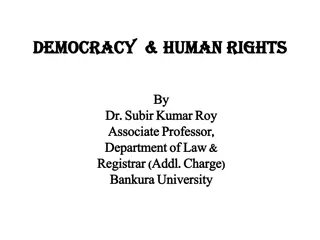Exploring Civil Rights Issues and Democracy
This presentation highlights the importance of civil rights issues and events like Jim Crow laws and Plessy v. Ferguson in the context of democracy. It prompts discussions on democracy's ongoing nature, challenges faced, and the essence of eternal struggle within it.
Download Presentation

Please find below an Image/Link to download the presentation.
The content on the website is provided AS IS for your information and personal use only. It may not be sold, licensed, or shared on other websites without obtaining consent from the author.If you encounter any issues during the download, it is possible that the publisher has removed the file from their server.
You are allowed to download the files provided on this website for personal or commercial use, subject to the condition that they are used lawfully. All files are the property of their respective owners.
The content on the website is provided AS IS for your information and personal use only. It may not be sold, licensed, or shared on other websites without obtaining consent from the author.
E N D
Presentation Transcript
Objective I can describe the importance of several civil rights issues and events. This Power Point presentation is adapted (both shortened and tailored to Arizona state standards) from the following lessons, Jim Crow in North Carolina, & Plessy v Ferguson and the Roots of Segregation, by CarolinaK12. org, and can be found in their entirety (including pdf files of the original Power Point presentations) here: https://k12database.unc.edu/wp- content/uploads/sites/31/2021/01/JimCrowinNCOntheBooks.pdf and https://k12database.unc.edu/wp-content/uploads/sites/31/2012/05/PlessyvFergusonRootsofSegregation.pdf
Big Idea Jim Crow laws were laws that legalized segregation in the United States.
Anticipatory Set: One Minute Think Time Then discuss with your table group: What does democracy look like to you? What images come to mind when considering the word? What actions do you relate to democracy? Who is included in or constitutes democracy ? Who is responsible for democracy? Write your answers on your Guided Notes. Stand and Share
Discuss & Share What do you think she means when she says that Democracy is never finished? Do you agree or disagree? Why? Based on this statement, do you think we have killed democracy? Why or why not? What evidence can you offer that democracy has been killed ? What evidence can you counter that illustrates that democracy is alive and well?
Discuss & Share What does he mean when he says that democracy can be lost ? Can you think of examples of these? What does he mean that the essence of democracy is eternal struggle ? What examples of such struggle can you think of? Do you agree with this definition of democracy and why?
Discuss & Share How does this quote connect with the other two? Why does our democracy always need improvement? Who is responsible for improving it?
Discuss & Share What do you already know about the term Jim Crow ? What is associated with Jim Crow ? What is segregation? What do you already know about the period of segregation in America?
Jim Crow: Origin The term Jim Crow originated in an1830s song performed by a white minstrel show actor, Daddy Rice. In a racist portrayal of African Americans, Rice covered his face with charcoal paste or burnt cork to resemble a black man, and then sang and danced a routine in a stereotypical caricature. By the 1900s, the name Jim Crow was used to identify racist laws and actions in the South that deprived African Americans of their civil rights.
Jim Crow: Laws Between 1877 and the mid-1960s, Jim Crow laws were in effect and represented a series of rigid, unjust laws with the purpose of keeping the races separated (segregation.) Blacks, and other minority groups were forced to use separate restrooms, water fountains, restaurants, waiting rooms, parks and swimming pools, libraries, hospitals, bus seats, and even cemeteries. Beyond the unfair laws, there was equally oppressive etiquette/behavior expected of African Americans, based on the misconception that Blacks were intellectually and culturally inferior to Whites.
Examples of Jim Crow: Etiquette 1870s-1960s Jim Crow etiquette prescribed that Blacks were introduced to Whites, never Whites to Blacks. For example: "Mr. Peters (the White person), this is Charlie (the Black person), that I spoke to you about." Whites did not use courtesy titles of respect when referring to Blacks (i.e. Mr., Mrs., Miss., Sir, or Ma'am). Instead, Blacks were called by their first names. Blacks, however, had to use courtesy titles when referring to Whites and were not allowed to call them by their first names.
Examples of Jim Crow: Etiquette 1870s-1960s People of different races were prohibited from sitting side by side when traveling (i.e. on buses and trains) and white motorists had the right-of-way at all intersections. Blacks were expected to never disagree with, challenge, curse at, or laugh at a white person. Blacks were to never show superior knowledge or intelligence to a white person. Blacks were not allowed to show public affection toward one another in public.
Discuss Which expectation do you find most disturbing? Why? How do you think the above behaviors came to exist and become the societal norm ? How do you think these rules and expectations affected society (black and white)? If the year were 1940, how would your life be different based on these rules and expectations?
Discuss If you were living during the Jim Crow era, what choices would you have as a citizen to make your displeasure with the Jim Crow way of life known? What would you be risking in dissenting?
Jim Crow Laws by State: Questions Partner up or work in table teams. You have a copy of the Jim Crow Laws by State at your desks. These are class copies! Please do NOT write in them. I will assign state/s to each pair or table teams. You will be examining some actual Jim Crow laws that were in existence in these state. Find your state and complete the Jim Crow Law Review questions for your state.
Jim Crow Laws: U.S. Map Once you have read and discussed your state s Jim Crow laws, fill in the outline of your assigned state with words, phrases and pictures that explain the Jim Crow laws that were once present in that state. Cut your map out. You will then tape it to the wall, piecing together as best you can a U.S. Map.
Discuss Looking at all of these unjust laws, what do you imagine it would have been like living during this time? Imagine you lived in Virginia and had a sick relative in Florida. What do you think it would have been like to make the trip as a black person? How would your travel have been impacted by Jim Crow laws? How is it possible that we live in a democracy, yet such unjust laws were passed and enforced for so many?
Plessy v. Ferguson 1890, Louisiana implemented the Separate Car Act, which required blacks and whites to sit in separate railway cars. Homer Plessy was only 1/8thblack. He could pass for white. At the urging of activist Albion Tourgee he sat in the white train car and then announced his ethnicity. He was arrested and removed. The case went to the U.S. Supreme Court, which upheld the law and said it was not in violation of the U.S. Constitution.
Plessy Plessy v. Ferguson, 1896 v. Ferguson, 1896 "That [the Separate Car Act] does not conflict with the 13th Amendment, which abolished slavery...is too clear for argument...A statute which implies merely a legal distinction between the white and colored races -- a distinction which is founded in the color of the two races, and which must always exist so long as white men are distinguished from the other race by color -- has no tendency to destroy the legal equality of the two races... We consider the underlying fallacy of the plaintiff's argument to consist in the assumption that the enforced separation of the two races stamps the colored race with a badge of inferiority. If this be so, it is not by reason of anything found in the act, but solely because the colored race chooses to put that construction upon it. Justice Henry Brown
Impact of Plessy v. Ferguson Shaped American views on race for the next 60 years. States used it as justification to implement more laws that codified racial segregation. Not overturned until 1954, in Brown v. Board of Education, when it was found to be unconstitutional.
http://www.nashvillescene.com/imager/jim-crow-20-are-republicans-just-exploiting-their-white-southern-base/b/original/1475173/7e2e/Jim-crow.jpghttp://www.nashvillescene.com/imager/jim-crow-20-are-republicans-just-exploiting-their-white-southern-base/b/original/1475173/7e2e/Jim-crow.jpg
Think, Discuss, Write & Share What year do you think this picture was taken? What makes you think this? What was this man doing while this picture was taken? Why is he carrying this sign? What message does the sign convey? How does this picture connect to what we ve learned about Jim Crow? What do you think this man wants? What does the image say about American democracy?
World War II The Turning Point "Help us get some of the blessings of democracy here at home before you jump on the 'free other peoples' band wagon and tell us to go forth and die in a foreign land." ~ P. B. Young (editor of the Norfolk Journal and Guide, an African American newspaper) "The nation cannot expect the colored people to feel that the U.S. is worth defending if they continue to be treated as they are treated now." ~ Eleanor Roosevelt
In spite of these injustices they faced at home, numerous African Americans were eager to join the armed forces and serve their country. At first the military proved reluctant to enlist them or else assigned them to menial roles. But in time the army and navy increased opportunities for black men and women. In 1940, 19 percent of black men were unemployed, and most black families lived in poverty. The huge defense buildup that began with the fall of France in June 1940 ended the Great Depression and brought back prosperity. But blacks were denied an equal share.
Using the slogan "We loyal Negro-American citizens demand the right to work and fight for our country," African Americans threatened to march on Washington to demand these rights. They forced president Franklin Roosevelt to issue Executive Order #8802 in 1948, which opened government jobs and defense contract work to African Americans on the basis of equal pay for equal work. It was the first presidential action against discrimination since Reconstruction.
The war years were tumultuous, but blacks sensed that out of this ferment change might come. After the bleak racism of the 1920s and the economic disaster of the 1930s, there was hope. African American newspapers conceived the "Double V" campaign victory over both America's enemies abroad and over Jim Crow segregation at home. In this hopeful atmosphere the NAACP increased the percentage of registered black voters in the South from 2 to 12 percent. Membership in the NAACP itself increased from 18,000 before the war to nearly 500,000 at its close.
As the Cold War began, America could not claim to be the defender of freedom and democracy when it practiced segregation and discrimination at home. President Harry Truman fully desegregated the armed forces in 1948, and a government report of 1947 called To Secure These Rightscalled for "the elimination of segregation from . . . American life." The stage was set for the civil rights movement.
Jackie Robinson An excellent embodiment of the spirit of change that was present during and after the years of WWII. Served his country, 42-44, as a 2nd Lieutenant in the U.S. Army. Never saw combat. Was arrested and court-martialed during boot camp when he refused to move to the back of the segregated bus during training. He was acquitted and received an honorable discharge.
Jackie Robinson Played baseball professionally. Baseball was segregated since the 1880s, so at first he played in the Negro Leagues. Chosen by Brooklyn Dodgers to help integrate major league baseball. Heralded the desegregation of major league baseball.
I often wonder whether we do not rest our hopes too much upon constitutions, upon laws, and upon courts. These are false hopes; believe me, these are false hopes. Liberty lies in the hearts of men and women; when it dies there, no constitution, no law, no court can save it . . . ~Judge Learned Hand
Closure: Exit Slip, CQS Why do Jim Crow laws no longer exist today? What do you think happened?


